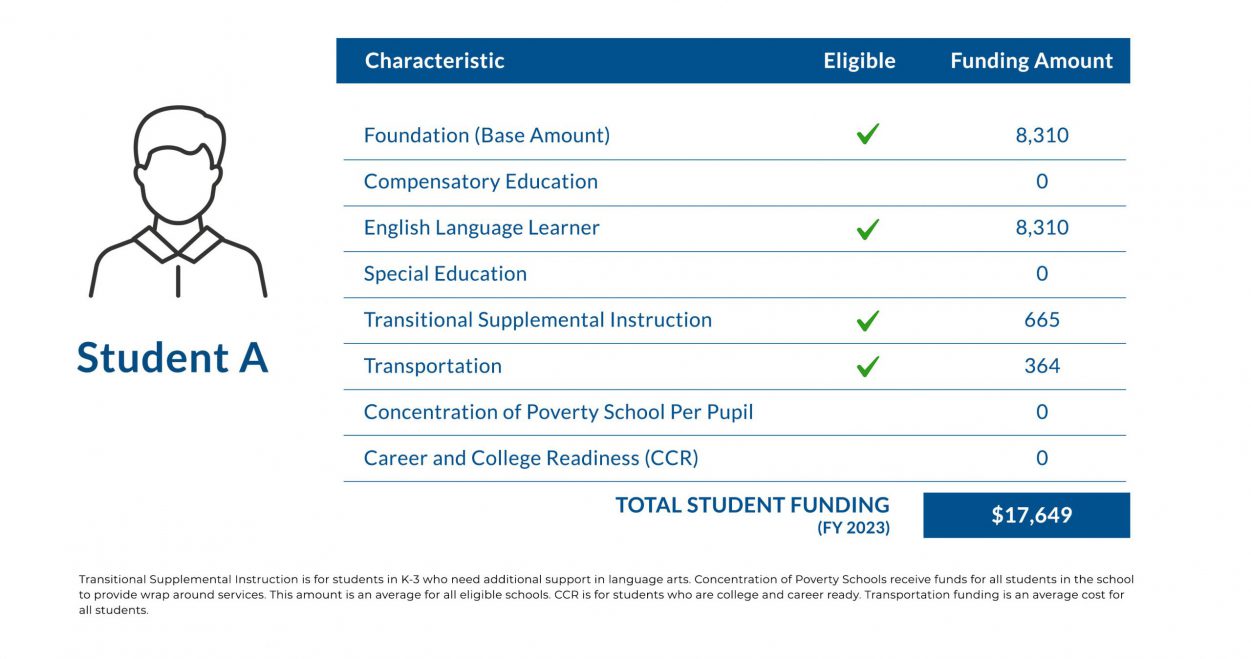Blueprint Funding: Formula and Accountability
The Blueprint for Maryland’s Future increases annual education funding to over $3.8 billion in 10 years and changes the way local school systems budget, allocate, and spend their resources to better support all Maryland students.
To deliver opportunity and promise of a better future to every Maryland child, the Blueprint specifies how funding is calculated to support programs and initiatives from prekindergarten through college and career. The Blueprint prioritizes equity and ensures opportunity for every student, regardless of family income, race, ethnicity, or ability.
How is funding allocated?
The Blueprint allocates funding to schools based on a weighted-student formula, which ensures that each school and each student has the resources they need. The funding formula provides resources to local school systems based on the number of students enrolled at each school and the characteristics of those students. The Blueprint also provides additional funding for specific programs that schools offer.
Understanding the Weighted Funding Formula
There are three types of components that go into the final Blueprint funding formula. Each component type is calculated differently to direct funding to address specific needs. The funding formula components can be either a base amount, a weighted amount, or a program amount and are calculated differently.
Base Per-Pupil Amount
The foundation base amount is the largest component of the Blueprint funding formula. It provides each school with the necessary financial resources to enable students to succeed. Each school is allocated the Per- Pupil Foundation Amount for each student enrolled in that school. For the 2022- 2023 school year, the Per- Pupil Foundation Amount is $8,310 for each student.
Weighted Amounts
Weighted amounts provide additional resources to LSSs based on the characteristics of the students that are enrolled in each school. Research shows that certain student subgroups require additional resources to successfully provide the appropriate educational services. For example, an average multilingual learner (ML) student requires more resources than an average non-multilingual learner student. Therefore, the Blueprint funding formula includes an multilingual learner weight to provide additional resources for every ML.
Program Amounts
Program amounts are allocated to LSSs based on factors other than student enrollment. For example, the Guaranteed Tax Base Aid program provides additional funding to a county school district based on a detailed formula that includes certain county tax revenues and the amount of funding provided to education. This program encourages less wealthy jurisdictions to maintain or increase local education tax effort.
The Blueprint funding formula has 12 components, each one providing funding for different programs or initiatives, supporting students to be successful in each aspect of their educational experience.
Base Amount
Target Per-Pupil Foundation
Weighted Amount
Compensatory Education Aid
Concentration of Poverty Aid (Per-Pupil Grant)
Prekindergarten Aid
Multilingual Learner Aid
Special Education Aid
Transitional Supplemental Instruction Aid
College and Career Readiness Aid
Career Ladder Aid
Program Aid
Concentration of Poverty Aid (Personnel Grant)
Guaranteed Tax Base Aid
Comparable Wage Index Aid
Transportation Aid
Phased-In Implementation on Blueprint Funding
The Blueprint for Maryland’s Future includes a phased-in implementation of its programs and initiatives over 10 years. As the Blueprint programs phase in over time, the corresponding financial resources also phase in over time. The financial phase-in happens through changes to the Per-Pupil Foundation Amount, changes to funding formula weights, and changes to eligibility for different funding formula components. This means that the amount of per-pupil and funding will change each year. Some examples of these phase-in changes included below.
Changes to the Per-Pupil Foundation Amount
The Per-Pupil Foundation Amount increases from $8,310 for each student in the 2022-2023 school year to $8,642 for each student in the 2023-2024 school year, with increases continuing all the way up to $12,365 for each student in the 2032-2033 school year.
Changes to Funding Formula Weights
Many of the other funding formula components change over time, including the Special Education Aid, which in the 2022-2023 school year allocates 86% of the Per-Pupil Foundation Amount, which is $7,146.60 for each student who requires special education services. This amount increases each year until the 2032-2033 school year when each student who requires special education services generates 146% of the Per-Pupil Foundation Amount, which is $18,052.90.
Changes to Eligibility
Some programs have eligibility requirements for the corresponding funding to be allocated. For example, in the 2022-2023 school year, families at or below 300% of the Federal Poverty Level (Tier I) are eligible for the free full-day prekindergarten. These eligibility requirements then expand starting in the 2024-2025 school year so that families between 300% and 600% of the Federal Poverty Level (Tier II) are also eligible for some financial aid for full-day prekindergarten.
Funding Accountability and Transparency
The Blueprint includes new mechanisms to create more transparency and accountability around how the funding is budgeted and spent. The Blueprint law makes this happen through a few key provisions.
In Maryland, State education funding, including the funding calculated through the Blueprint funding formula, is allocated to the county school districts. Each school district is then expected to distribute the funds to their individual schools. The Blueprint increases accountability for this process through the new “minimum school funding” provision which requires districts to distribute funding to specific schools based on an individual school’s student enrollment.
Additionally, the Blueprint directs the Maryland State Department of Education to create and implement a new financial reporting data system that collects, analyzes, and reports on the finances of each school district. Based on the financial data collected by the new financial reporting data system, the department will also submit reports on school–level expenditures to the Accountability and Implementation Board each year.
The Blueprint for Maryland’s Future
Delivering opportunity and promise of a better future to every Maryland child, the Blueprint for Maryland’s Future will transform the State’s prekindergarten through postsecondary systems with sweeping policy changes and an unprecedented investment of State and local resources.





